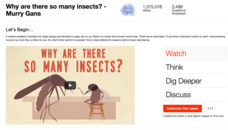SciShow Kids
What's a Meteor Shower?
Have you ever looked up at night and seen a streak of light flash across the sky? Some people call that a "shooting star," but it's not actually a star at all! Join Jessi and Squeaks to learn what shooting stars really are and how they...
SciShow
Robots Inspired By Animals
Learn about the robots inspired by animals with Hank! Chapters View all ROBOTS ARE JUST MACHINES DESIGNED TO ACCOMPLISH ATASK 0:31 THERE'S A LOT MORE TO FLYING THAN JUST FLAPPING WINGS 1:08 MAPPING SYSTEMS TEND TO BE COMPLICATED,...
SciShow Kids
Fireflies: Nature’s Baffling Blinkers Animal | Science for Kids
Have you ever wondered how fireflies twinkle and blink on lovely summer nights? Join Jessi and Squeaks at the fort to learn their secret!
Curated Video
The Risky Paleo Diets of Our Ancestors
We can track our history of eating just about anything back through the fossil record and see the impact it’s had on our evolution. Throughout time, part of the secret to our success as a species has been our early - and sometimes fatal...
Curated Video
Mechanical Plant Defenses
Plants defend themselves using a variety of physical features such as raphides and trichromes. Let's look at some of these mechanical plant defenses and how they function.
TED-Ed
Should We Eat Bugs?
Cricket cookies? Mealworm mac and cheese? Bugs are super nutritious! Why don't we eat them? Viewers discover the history of entomophagy, that is, the practice of eating insects and spiders, by viewing a fascinating video that explores...
California Academy of Science
Bugs for Breakfast
More people in the world eat bugs as a source of protein than the number of people who don't eat bugs. Viewers consider bugs as a food source to solve multiple issues. Our Hungry Planet introduces bug-based food as a possible solution to...
TED-Ed
A Simple Way to Tell Insects Apart
Did you know an insect has unique mouthparts based on what and how it eats? This is a simple way to identify the order an insect belongs to. Watch a video that explains the interesting world of insect mouthparts.
The Brain Scoop
How to Pin an Insect
Have you ever tried to pinpoint the exact type of insect captured? Scientists collect insects and pin them for future study to do just that. The video explains how to properly pin an insect to display the unique body parts and features....
ABCMouse
Big Bug and Little Bug
Impart the value of kindness and reinforce rhyming CVC words with a short video about a bug who offers help to another bug in need.
The Brain Scoop
Insect Adventure, Part 2
Scholars look forward to using the pooter, otherwise known as an aspirator, to collect insects. The video demonstrates how to collect bugs in mesh nets, canvas nets, and in pooters to better study them. The second installment of a...
TED-Ed
Why Are There so Many Insects?
Bugs! Bugs! Why are there so many bugs? Find out why is this short video.
PBS
When Insects First Flew
Insects developed wings and the ability to fly earlier than any other animal—when exactly did that happen? Scientists know this fact but struggle to explain when insect wings developed and how this entirely new structure appeared. PBS...
SciShow
Wasp Nests and Bee Hives
It turns out that wasps and bees have a lot more in common that the word ouch! Junior entomologists explore the similarities and differences between flying, stinging insects with the 136th installment in a 143-part series of science...
PBS
The Age of Giant Insects
The largest arthropod that walked on land measured more than two meters long. An intriguing video looks invertebrates throughout the history of Earth. It explains the drastic differences and why scientists theorize they evolved in this...
Deep Look
The Ladybug Love-In: A Valentine's Special
Ladybugs live alone most of the year but gather together for winter. An informative video explains that this gathering serves two purposes: mating and hibernating.
Deep Look
Nature's Scuba Divers: How Beetles Breathe Underwater
Some insects breathe air yet live underwater. The video explains how they carry air with them and the scientific principles behind this ability. It focuses on beetles and surface tension as the concept of nature's scuba divers becomes...
Crash Course
Electronic Computing: Crash Course Computer Science #2
What insect is the origin of the phrase computer bug? Scholars view a video to learn about the challenges with early computing efforts, including moths finding their way into mechanical relays. From vacuum tubes to transistors, the video...
TED-Ed
Mating Frenzies, Sperm Hoards, and Brood Raids: the Life of a Fire Ant Queen
The dramatic story of the life cycle of a fire ant queen is featured in a short video that details the queen's struggle to survive amid floods, fierce battles, and forage wars.
TED-Ed
Mysteries of Vernacular: Earwig
Sometimes a folk tale takes root and, even if it is not true, can determine the development of a word and its associated meanings. Take earwig, for example. An earwig has a false reputation for crawling into your brain, but the name...
Other popular searches
- Bugs and Insects
- Bugs or Insects
- Bugs Insects
- Bugs and Insects Crafts
- Bugs and Insects Art
- Insects and Bugs Stencils
- Theme Insects and Bugs
- Bugs and Insects Prue School
- Studying Bugs and Insects
- Bugs and Insects Pre School
- Bugs and Insects Worksheet
- Bugs or Insects Anatomy

















